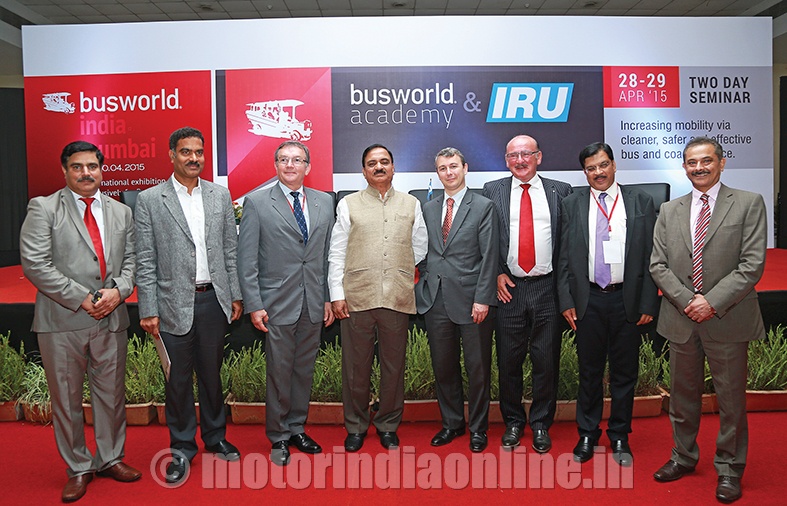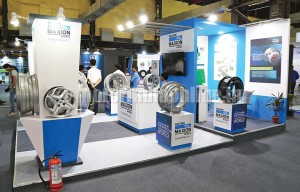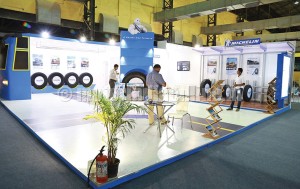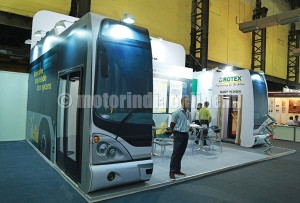The Indian bus industry grows by 50,000 units every year as it remains the second largest market in the globe. With liberalization of the Indian market and an expansion in the well-informed commuter base, many foreign companies have started investing in India. Modern buses with highly advanced facilities and services have been introduced on Indian roads. The Government has also stepped up efforts to promote the use of electric and hybrid vehicles in a mission mode. Further, the introduction of modern technologies like ITS, GPS, hybridization, etc., has led to a big rise in demand for buses in many Indian cities and towns across the country, necessitating improved safety, reduced traffic congestion and higher energy efficiency while ensuring a greener environment coupled with economic productivity.
The sixth edition of Busworld India held in Mumbai from April 28 to 30 was a perfect platform for presentation of all the latest developments in the bus industry as it threw light on the tremendous potential of the country’s bus market. It was an equally good example of a focused B2B trade fair with almost every visitor who attended the show having relevance to the bus industry.
The biennial event which was inaugurated by Mr. Diwakar Raute, Maharashtra Minister for Transport, on April 28, received excellent response from all stakeholders in the bus industry – bus manufacturers, STUs, fleet operators, bus body builders as well as component suppliers. Several new products and technologies were launched at the fair amidst discussions on the new bus body code, updated regulations and norms, and so on, alongside which experts from the industry were involved in seminars and conference sessions held on the occasion.
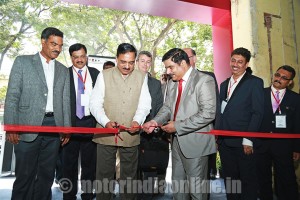
On the first day of the seminar, the International Road Transport Union (IRU) President, Mr. Janusz Lacny, set the tone for proceedings, followed by addresses by speakers from the UN-Habitat, EMBARQ, Prasanna Purple Mobility Solutions and IRU, who spoke about urban mobility, BRT systems and the role of private operators in developing the industry. Together, they concluded that there is a need to organize a high-level IRU debate in the country.
On day two, seminar introduction was given by Mr. Jan Deman, Director, Busworld Academy, with its focus on two main themes: safety, focusing mainly on fires, and sustainability. Topics such as measures for fire prevention within vehicles and driver alertness were discussed. This was followed by discussion on ‘buses and coaches as a solution for environmental problems’. Different alternative powertrains and their advantages were also discussed.
Overall, one key aspect was easily identified: India needs a lot of more buses and coaches in the near future, replacing the other more polluting vehicles, thus resolving both air pollution and congestion problems. The potential for the industry is huge simply because production of buses should grow from 54,000 vehicles per year to around 150,000 units, which is nearly a three-fold rise.
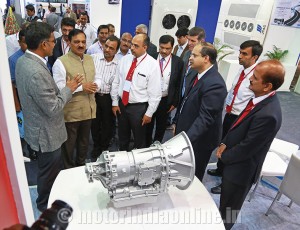
The exhibition also witnessed participation by some of the big brands in the Indian and global bus industry. The key highlights are given below:
Scania, the biggest name at the show, displayed its ethanol engines for the first time in India. The company also showcased its ethanol bus and 13.7 m Metrolink HD coach. It is to be noted the Metrolink coach has had great success already in India with its 14.5 m variant.
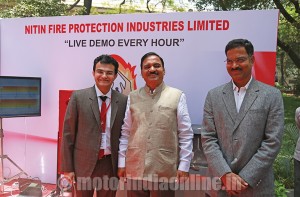
SML Isuzu displayed its range of buses in various seating configurations, including the FR1318, an 11 m AC coach powered by a 4-cylinder 177hp engine, the S7 staff bus, a 9 m bus intended for staff travel, and a compact 6 m 13-seater executive AC bus.
The show-stopper, however, was the ‘MAMMOTH’ front-engine coach showcased by the MG Group. The coach, which was officially launched by Mr. Diwakar Raute, has been developed by the MG Group along with strategic partnership with MAN Trucks India on the latter’s CLS16.22 12 m chassis. The MAMMOTH is a 44-seater AC coach and will have exclusivity for MAN. It has lots of thoughtful features like the EM secure, an removable rear exit with walkway staircase to help passengers evacuate in case of an emergency. We have given a detailed report on the MAMMOTH elsewhere in this edition.
It is a known fact that the Indian bus market is really big and has a lot of bus body builders, but the effort to develop of a complete bus has always been hard to come by, with only a few making an attempt in the past, like the Lexia from Sutlej, for instance. The latest edition of Busworld saw two body builders showcase a complete bus. Veera Vahana launched its maiden city bus which has been completely manufactured in-house, emphasizing the ‘Make in India’ movement. The bus, named VR2 LE, is a BS-IV complaint, diesel-powered premium low-entry city bus with a host of features and specifications fully complying with the new bus body code. With major aggregates sourced from various renowned manufacturers, the chassis has been indigenously designed and developed. The company aims to sell around 50 to 100 units annually and has priced it nearly 20 per cent lower than competition in the segment. The vehicle has specific USPs like PTO-driven hydrostatic cooling system, right-side emergency exit and completely fire-retardant interiors, etc.
ACGL was part of Busworld for the third time and put out a range of buses from the LHD school buses to luxury buses, including an Amphibus built to run in both road and water as part of a project developed for the Tourism Department of Goa in technical alliance with an American company named Advanced Amphibious Design. The proto bus is yet to undergo complete certification and is likely to hit roads (and water!) soon.
On the supplier side, Chemito launched its new range of products, including wireless display boards and GPS-enabled display boards. The fire safety expert Dafo, along with its Indian partner Safex, showcased its range of products and expressed optimism on the market, buoyed by the response received from STUs and OEMs at the show.
Eberspaecher launched its new compact AC units between 12 kW to 30 kW for 10 m and 11 m buses. In line to cater to the unique Indian market requirements like higher air flow, Eberspaecher has brought products with new technologies like brush-less technology and a new range of single controllers for defroster, air-conditioning and heating, which make the system compact and lighter in weight.
Like the previous edition of the show, the event had many AC manufacturers, including Spheros, SONGZ, Subros, Thermo King and Jingyi, showcase their full range of products. With the current penetration of air-conditioning in the Indian bus market only of around seven per cent, there is tremendous head room for growth, which all the AC makers are looking to capitalize on.
Luxury seating systems leader Harita showcased a patented proto concept which was revealed only to key customers, in addition to another new concept of reclining seats with three-point integration.
Some of the other well-known and reputed exhibitors at the show included Allison, Gibraltar, Hübner, Lamilux, Pacoline, Sika, Power Electronics Pee Aar Exim and Valeo. With the bus body code kicking in and fresh volumes expected under the currently-active second phase of JnNurm, most participants expressed confidence on the industry growth. With the Indian bus population currently at around 7.5 million units, there is a need for another 1.5 million buses in the coming years, which is the clear bottomline regarding the potential of the Indian bus market.
Text by Preetham Sri Krishna Vignesh & N. Balasubramanian | Photos by M. Sathya
